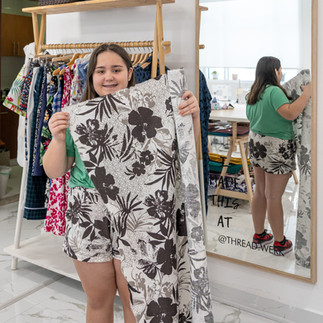Unravelling the Benefits of Sewing
- Maria
- Mar 15, 2024
- 5 min read

When I started ThreadWerk back in 2018 (how far it’s come!) it was to share my passion for making my own clothes, as well as contributing to less fast fashion. Through the many years I’ve had of making my own clothes and teaching others in the various classes and workshops we run, I’ve learnt that sewing has a whole host of benefits that are good for young and old.
I started sewing my own clothes when I lived on a small island in Malaysia for a number of reasons. Clothes shops were practically non-existent where we lived and there was also very little to do. Sewing was a new hobby for me, but it was one that I truly enjoyed. Even back then, I could see that this craft had more benefits than simply fixing up old clothes.
Sewing is a life skill
Sewing used to be a skill that many people, especially girls, learnt from a young age. It was either passed on by a relative, such as a mum, sister or grandmother, or even learnt at school. Thirty years ago, practically everyone knew how to sew on a button or mend a tear in a shirt with needle and thread. Passing on these skills dropped away for a few decades; however the pandemic brought a renewed interest in crafts such as crocheting, knitting and sewing. When people were locked in their homes for long periods, they sought out new hobbies. Thankfully, one of these is sewing. I believe sewing is an essential skill, and it offers practical benefits that can serve you throughout your life.
I’ve worked in jobs that made me very unhappy, yet since starting my sewing business, I have never been happier. After seeing the positive impact that it had on me and then on the students that I’ve taught over the past few years, I realised that taking up sewing has so many amazing benefits that people never really discuss. This prompted me to research further into the topic, consult with experts and write this blog post.

Why sewing is good for you
1. Sewing is good for brain function
Sewing is a wonderful activity that naturally stimulates your brain in various ways. It encourages problem-solving as kids figure out how to thread needles and follow patterns, which in turn fosters their independence and perseverance.
It's a great way to introduce spatial awareness and basic math concepts too, as they measure, cut, and piece fabric together. When sewing, children’s minds are clear, active and focused on the job in hand, which helps them with concentration in other areas too.
2. The needle and thread improve dexterity
Did you know that every single stitch improves your motor skills?
Working with fabric and thread is particularly good for children as it helps them develop hand-eye coordination. Needles need to be threaded, darts must be marked, and seam allowances measured, which all contribute to the development of fine motor skills.
Maintaining your dexterity is vital as we grow older too. Sewing is a good way to keep your hands active and because you’re dealing with little items such as fine needles and thread, you keep those skills for other areas of your life.

3. Mindfulness is a positive side effect of sewing
Ever present digital devices have affected our attention spans. However, sewing encourages mindfulness. According to The Health Psychologist, Dr Sula Windgassen sewing “can help to harness attention to the present in a way that feels comfortable and pleasant,” She adds that, “repeating these experiences can make it feel more accessible to be in the moment in other situations too.” For children, sewing helps them enter a state of mindfulness, away from other distractions.
4. Emotions can be regulated through sewing
When you practice a hobby that uses your hands, Dr Sula explains, it “allows you to activate... the ‘default mode network’ in your brain.” The default mode network, or DMN, is when your brain isn’t engaged in anything demanding – we usually call it autopilot. When you’re in this mode, it helps to regulate your emotions and has a “protective effect on mental health”.
When you’re focusing on sewing and not external events, it lets your mind calm and gives time for self-reflection. This has a discreet effect on balancing any heightened emotions.

5. Sewing can boost your mood and improve your self-esteem
Crafts like sewing prompt the release of dopamine, which triggers the brain’s reward system. This makes us associate sewing with feelings of pleasure. Because our minds like it when we release dopamine, we’re inclined to repeat those behaviours again to gain that same warm feeling. If you keep returning to your sewing projects, it acts like a natural anti-depressant and it’s one you can take over and over with no side effects!
Thos pleasurable feelings aren’t just temporary – they have longer term side-effects too. Dr Sula explains how our self-esteem is “positively influenced by self-efficacy”. Self-efficacy is your own belief in your ability to complete a task skilfully. She adds that if “you can easily see the output of your labour, especially if it is aesthetically pleasing to you, (it) can activate reward circuits… that give your mood a boost.” When you feel like you’ve completed a pattern and can admire your own work, that enhances your self-esteem.

6. Sewing can relieve stress
As well as making you feel happier, sewing can relieve stress. You don’t need to think about what is causing you stress as you’re focused on threading your needle, following your pattern, or even just choosing fabric. As stated in Forbes, sewing has been compared to meditation, because it has a similar calming effect on your body and mind.
If you’re stressed about the environment, sewing contributes to sustainability. You can repurpose fabric from around your home – an old bedspread can become a tablecloth, or you can make cushion covers from old curtains. When you cast a creative gaze over items that you consider worn out, you’ll find possibilities you might not have considered before.
When you come to a sewing group or class regularly, the simple act of looking forward to the moment becomes a stress reliever in itself.
7. Sewing is a brilliant creative outlet
Sewing sparks creativity, allowing children to explore colours, textures, and designs while crafting their own unique projects. For those who think they aren’t creative, they soon discover that picking their colours and patterns displays their individual taste and inspires them to be even more creative. Once the creative juices are flowing, you’ll find they come up with more ideas for pieces they want to make, as they become excited by the possibilities.
Making my own clothes has allowed me to define my own style and not be dictated by what is available in stores. It is incredibly fulfilling to choose my own fabrics and patterns and create what looks good on me. I’ve heard several other women express this after taking up sewing through ThreadWerk.
Anyone can learn to sew
From myriad mental health benefits to the social connection offered at Threadwerk, there simply are no negative side effects of sewing! As long as you have use of your hands and eyes, you can learn to sew and there are so many reasons to start.
Get in touch if you’d like to know more about the classes and workshops we offer. Thanks to Dr Sula Windgassen, The Health Psychologist, for her expert comments here, find her on Instagram @the_health_psychologist_or visit www.healthpsychologist.co.uk


















